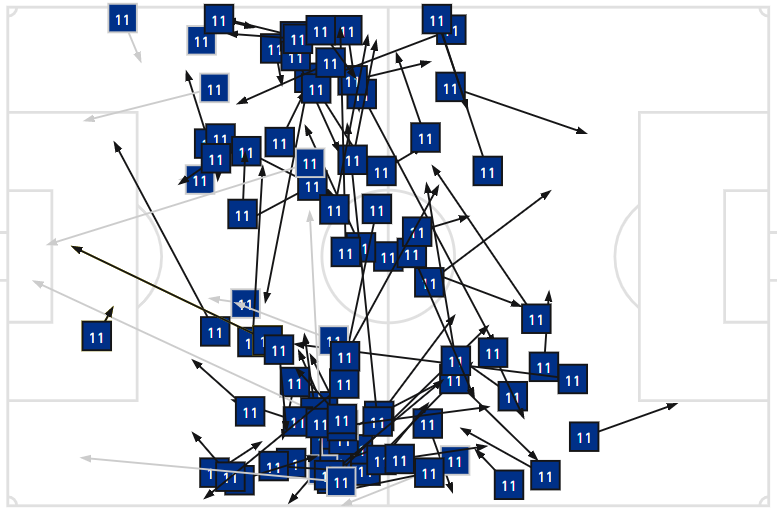When C.J. Sapong gave Nashville SC a 1-0 lead in the 13th minute on Saturday, FC Cincinnati was in a situation it has repeatedly struggled in all season: trying to break down a defense defending a lead. Though Nashville scored two more goals before the final whistle, outside of a few promising actions, FC Cincinnati never really threatened.
There are a couple of factors as to why. The first comes down to Nashville scoring an early goal and happily conceding space and the ball to FCC, trusting its near-league best defense to stifle the Orange and Blue’s attack. Nashville started the match with three center backs and for large stretches, they were happy to defend in a back five with two central midfielders dropping deep as well.
The second issue — and forgive me if you’ve heard this one before — comes down to lack of chance and shot creation from FC Cincinnati when it has the ball. Despite enjoying 64% possession and completing 90% of its 673 passes, FCC rarely created dangerous opportunities. Per Football Reference, during the match, FCC had 143 touches in Nashville’s defensive third and just 12 in Nashville’s penalty area.
As a comparison, the last time these teams met, Nashville thoroughly dominated the ball chasing an early FCC two-goal lead. A heroic effort by Przemysław Tytoń was the only reason FCC escaped with a point in a 2-2 draw. In that match, one where FCC had 42% possession, FC Cincinnati had 69 touches in the attacking third and nine in the attacking penalty area. Even in situations where FCC has the ball in final third, it still struggles to move it into the box, creating dangerous scoring opportunities.
These struggles translating possession into chances is nothing new for FC Cincinnati. On Saturday, FC Cincinnati’s seven shots were from an average distance of 19.7 yards from goal. Only two, both relatively low-percentage headers coming off set-pieces, were from less than 10 yards from goal.
Until FC Cincinnati can find ways to create more chances during the run of play, expect to see opposing teams continue to sit deep and make FCC beat them.
A New Look Front Three But Paired With A Stagnant Midfield
When coach Jaap Stam’s lineup was released an hour before kickoff, it looked likely that FC Cincinnati would be returning to a 3-5-2. On the field however, the formation ended up being a 4-3-3, with Caleb Stanko joining Yuya Kubo and Haris Medunjanin in midfield and Luciano Acosta lining up as FCC’s nominal left-winger.
The new-look front three of Acosta, Brenner, and Álvaro Barreal was very fluid, with all three players interchanging across the attacking band. Just look at Acosta’s pass map against Nashville, from MLS Soccer. Though listed as a winger, Acosta drifted all over the field to get on the ball.

Flexibility and interchange can be valuable tactically. However, Acosta is still tasked with too much ball progression, linking defense to attack. Acosta was FC Cincinnati’s main force moving the ball into the final third. However, when Acosta is the one moving the ball forward, he’s often not in a position to be the one to try to set up a killer ball to a teammate.
Also, outside of Acosta, FC Cincinnati’s midfield was not able to provide the ball to attackers in dangerous areas. The combined passing maps for Medunjanin, Stanko, and Kubo show a lot of horizontal passes completed but almost none into “Zone 14” or into other positions on the field that might unlock a defense sitting deep.

Stam seems unwilling to set up his teams to exploit wide areas of the field and hit crosses into the box. Stam’s choice in wingers on Saturday limited that option as well. As previously noted, Acosta playing as a winger will not provide much width because he’ll be dropping into whatever space is available to find the ball. Barreal, a left-footed player playing on the right, isn’t going to provide much width in the attack either. Stam utilized Joseph-Claude Gyau in an interesting way (more on that later), but the strength of his game is not whipping crosses into the box after making an overlapping run on the right.
Playing with more width might have helped FC Cincinnati create openings in Nashville’s defense. So would have someone in midfield taking more risks to try to put FC Cincinnati’s attacking players into dangerous positions. Until FC Cincinnati figures out how to make it uncomfortable for defenses sitting deep, the Orange and Blue will continue to struggle to create chances.
Gyau’s Deployment
One last interesting note that caught my eye on Saturday was how Stam utilized Gyau, specifically in possession. When FC Cincinnati attempted to build out of the back, Gyau often pushed higher up the field, staying wide on the right side of the field. With Gyau wide, Barreal sat narrower, offering FCC another central option. Medunjanin filled the defensive hole at the right back spot, also giving FCC a better passer there than if Gyau just stayed home.
Gyau capitalized on playing higher up the field, driving the ball forward on the dribble and getting on the ball in advanced areas, finishing only behind Acosta in final third touches. As can be seen from his WhoScored touch map, Gyau offered FCC another, consistent option in Nashville’s half.

Gyau offers Stam a dynamic dribbler and a means to progress the ball forward. Gyau’s final ball service has been lacking so far this season, but this tactical wrinkle from Stam puts his right back in a position to contribute more in the attack.














